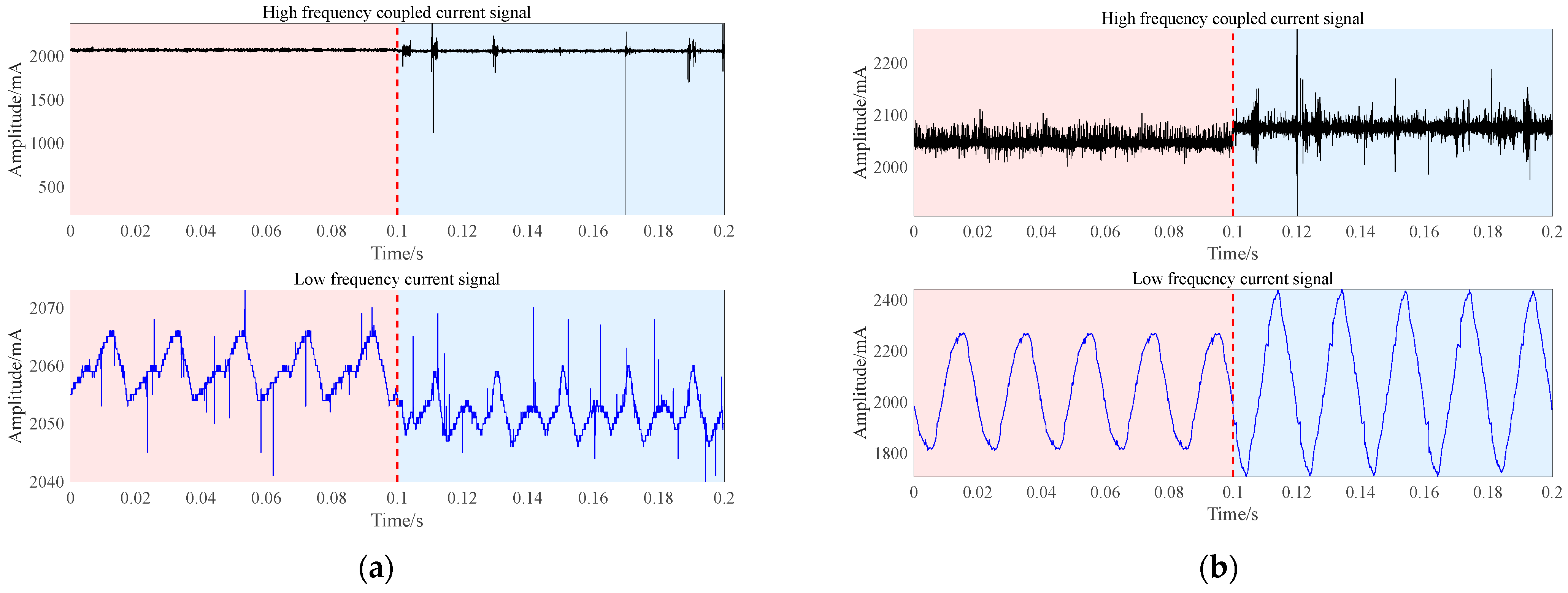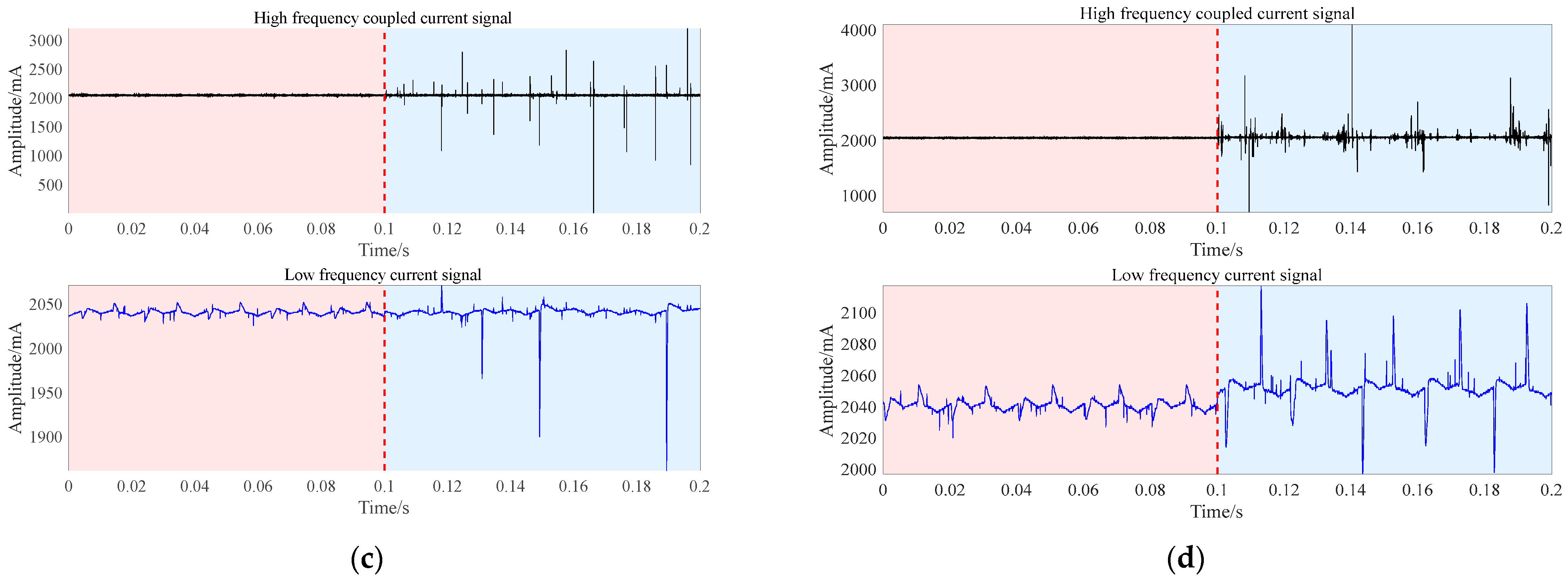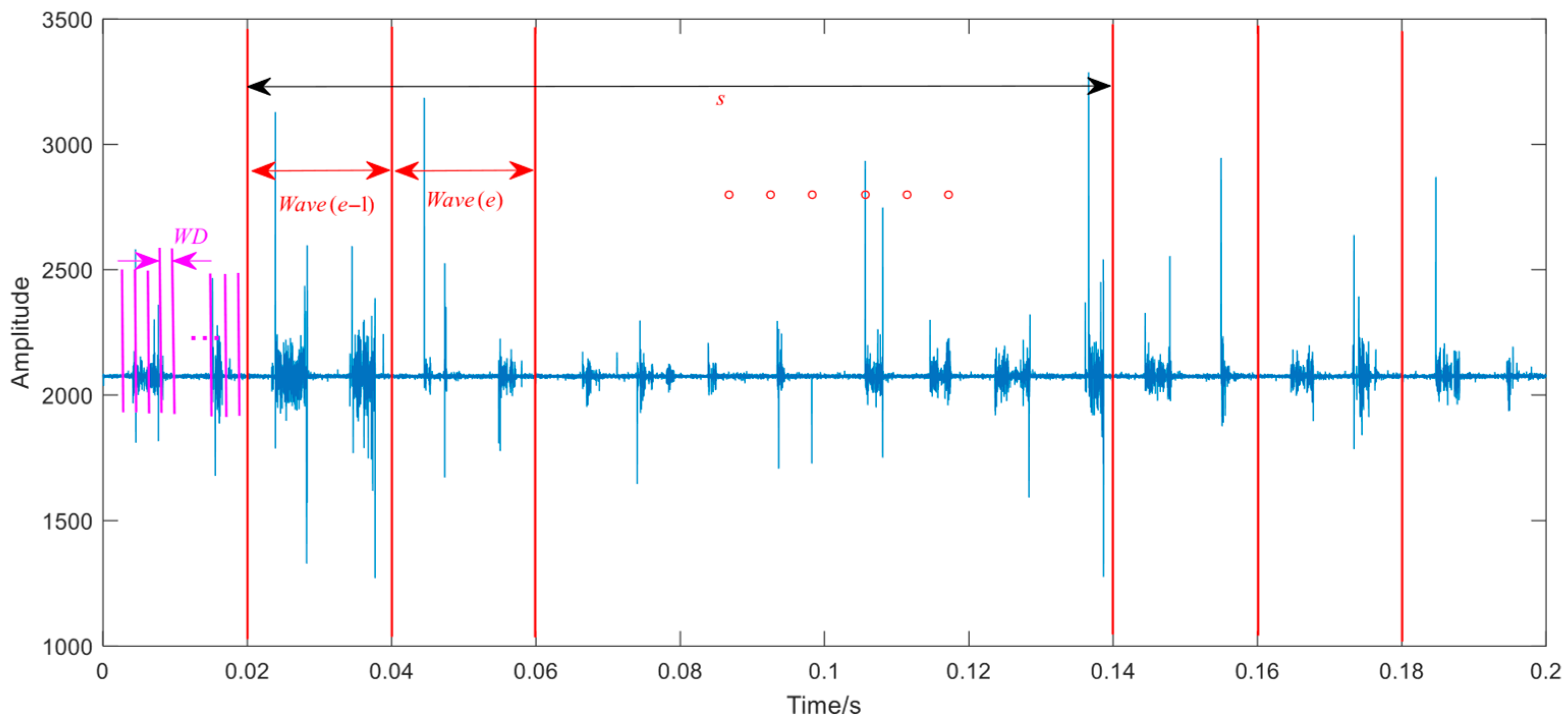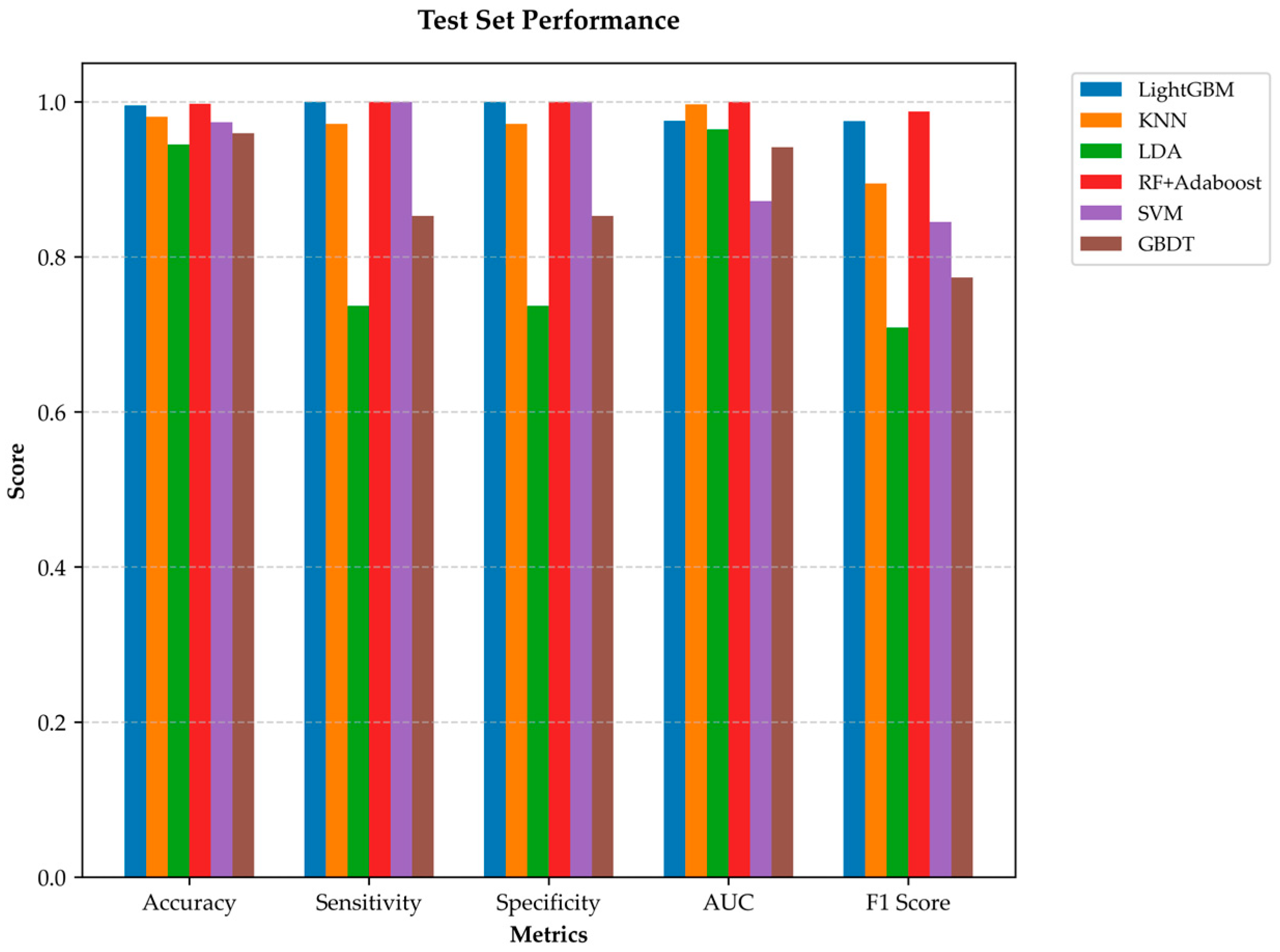Detection and Classification of Low-Voltage Series Arc Faults Based on RF-Adaboost-SHAP
Abstract
1. Introduction
- (1)
- Feature Selection with Physical Relevance: RF evaluates and ranks features extracted from arc fault signals, ensuring that the most physically meaningful and discriminative features are retained.
- (2)
- High-Accuracy Detection with Adaboost: The selected features are input into an Adaboost classifier, enhancing detection accuracy and robustness under complex load conditions.
- (3)
- Transparent Model Interpretation: SHAP values quantify the contribution of each feature to the final decision, providing interpretable results that bridge data-driven methods and physical mechanisms.
- (4)
- Comprehensive Experimental Validation: Extensive experiments on a self-built arc fault dataset demonstrate superior accuracy and robustness compared with traditional models, while offering enhanced interpretability.
2. Feature Extraction and Preprocessing
2.1. Collection of Series Arc Fault Data
2.2. Feature Design and Normalization
3. RF-Adaboost Detection Algorithm
3.1. Random Forest Feature Selection
- (1)
- The mean value of the full pulse amplitude of E is PMean_Mean:
- (2)
- The pulse factor is the mean value of the pulse amplitude in the full wave E is PMean_Index:
- (3)
- E is the mean of the maximum pulse interval in the full wave call PIntvalMax_Mean:
- (4)
- E is the maximum value of the average pulse interval in the full wave call PIntvalMean_Max:
- (5)
- The pulse factor of the average energy of the full wave E is E_Index:
- (6)
- The mean value of the average current of E full wave is IMean_Mean:
- (7)
- The mean value of the full wave amplitude symmetry factor E is AmpSymIndex_Mean:
- (8)
- E is the maximum value of the full wave amplitude symmetry factor call AmpSymIndex_Max:
- (9)
- The number of current triangle changes in E full wave is TrianglePulseNum:
3.2. Adaboost Classifier Optimization
3.3. Decision Interpretability Analysis Based on SHAP
4. Experimental and Result Analysis
4.1. Dataset and Evaluation Index
4.2. Result Comparison Analysis
4.3. Confusion Matrix Analysis
5. Conclusions
Author Contributions
Funding
Data Availability Statement
Conflicts of Interest
References
- Yang, J.H.; Fang, H.Y.; Zhang, R.C.; Yang, K. An Arc Fault Diagnosis Algorithm using Multinformation Fusion and Support Vector Machines. R. Soc. Open Sci. 2018, 5, 180160. [Google Scholar] [CrossRef] [PubMed]
- Yu, Q.F.; Lu, W.H.; Yang, Y. Multi-branch Series Fault Arc Detection Method based on Deep Long Short-term Memory Network. J. Comput. Appl. 2021, 41 (Suppl. 1), 321–326. [Google Scholar]
- Zhang, S.W.; Zhang, F.; Wang, Z.J. Series Arc Fault Identification Method Based on Energy Produced by Wavelet Transformation and Neural Network. Trans. China Electrotech. Soc. 2014, 29, 290–295, 302. [Google Scholar]
- Jiang, R.; Fang, Y.D.; Bao, G.H. An Improved Mayr Model Applicable to Low Voltage Series Arc Faults. Electr. Appl. Energy Effic. Manag. Technol. 2019, 21, 14–18. [Google Scholar]
- Wang, H.T.; Kang, J.Y.; Lin, Y.G. Low-Voltage Series Arc Fault Detection Based on Multi-Feature Fusion and Improved Residual Network. Electronics 2025, 14, 1325. [Google Scholar] [CrossRef]
- Wang, R.; Ma, T.T.; Zhao, Y.C. A series photovoltaic DC arc fault locating method based on electromagnetic radiation delay estimation. Trans. China Electrotech. Soc. 2023, 38, 2233–2243. [Google Scholar]
- Wang, Y.; Liu, L.M.; Li, S.N. Arc Fault Detection based on Empirical Wavelet Transform Composite Entropy and Feature Fusion. Power Syst. Technol. 2023, 47, 1912–1919. [Google Scholar]
- Gao, Z.W.; Xiang, Y.H.; Lu, S.X.; Liu, Y.X. An optimized Updating Adaptive Federated Learning for Pumping Units Collaborative Diagnosis with Label Heterogeneity and Communication Redundancy. Eng. Appl. Artif. Intell. 2025, 152, 110724. [Google Scholar] [CrossRef]
- Yang, K.; Zhuang, H.H.; Dong, Y.L. Modeling of Electric Vehicle Driving Motor and Load Simulation System and Arc Fault Simulation Research. J. Electron. Meas. Instrum. 2024, 38, 237–245. [Google Scholar]
- Wang, W.; Xu, B.Y.; Zou, G.F. Low-voltage AC Series Arc Fault Detection Method based on Voltage Characteristic Energy. Power Syst. Prot. Control 2023, 51, 81–93. [Google Scholar]
- He, Z.P.; Li, W.L.; Deng, Y.Y.; Zhao, H. The Detection of Series AC Arc Fault in Low-Voltage Distribution System. Trans. China Electrotech. Soc. 2023, 38, 2806–2817. [Google Scholar]
- Shan, X.J.; Zheng, X. Research on Identification Model of Low Voltage Arc Characteristics Based on Wavelet Analysis. Electr. Energy Manag. Technol. 2021, 6, 7–14. [Google Scholar]
- Jiang, J.; Li, W.; Wen, Z.H. Series Arc Fault Detection based on Random Forest and Deep Neural Network. IEEE Sens. J. 2021, 21, 17171–17179. [Google Scholar] [CrossRef]
- Jin, H.; Gao, W.; Yang, G.J. An intelligent Detection Method for Series Arc Fault of Photovoltaic Array. Electrotech. Electr. 2025, 1, 3–47, 66. [Google Scholar]
- GB/T31143—2014; General Requirements for Arc Fault Detection Devices (AFDD). China National Standardization Administration: Beijing, China, 2014.
- Chou, Y.; Zhang, A.; Gu, J.; Liu, J.; Gu, Y. A recognition method for extreme bradycardia by arterial blood pressure signal modeling with curve fitting. Physiol. Meas. 2020, 41, 074002. [Google Scholar] [CrossRef] [PubMed]
- Xu, M.M.; Zhou, H.P.; Zhao, Y.Q. Research on the Detection of Forest Fire based on Spatiotemporal Features of Flame Video. J. For. Eng. 2016, 1, 134–140. [Google Scholar]
- Dash, P.K.; Rekha, P.S.; Prasad, E.N.V.D.V. Detection and classification of DC and feeder faults in DC microgrid using new morphological operators with multi class AdaBoost algorithm. Appl. Energy 2023, 340, 121013. [Google Scholar] [CrossRef]
- Zhi, N.; An, Y.W.; Zhao, Y. Intelligent Island Detection Method of DC Microgrid based on Adaboost Algorithm. Energy Rep. 2023, 9, 970–982. [Google Scholar] [CrossRef]
- Zeng, S.Q.; Deng, H.; Duan, J.H. Fitting Probability Distribution of Aedes Vector Density with Cubic Spline Function and Its Risk Assessment. Chin. J. Health Stat. 2024, 41, 414–418. [Google Scholar]










| Test Method | Accuracy | Sensitivity | Specificity | F1 Score | Kappa Coefficient |
|---|---|---|---|---|---|
| RF + Adaboost | 0.9708 | 0.9814 | 0.9815 | 0.9803 | 0.9521 |
| KNN | 0.9628 | 0.9533 | 0.9533 | 0.9522 | 0.9113 |
| LDA | 0.9221 | 0.7318 | 0.7618 | 0.7036 | 0.9057 |
| SVM | 0.9625 | 0.9792 | 0.9812 | 0.9485 | 0.9309 |
| LightGBM | 0.9701 | 0.9812 | 0.9802 | 0.9708 | 0.8669 |
| GBDT | 0.9371 | 0.9402 | 0.9402 | 0.7804 | 0.8923 |
Disclaimer/Publisher’s Note: The statements, opinions and data contained in all publications are solely those of the individual author(s) and contributor(s) and not of MDPI and/or the editor(s). MDPI and/or the editor(s) disclaim responsibility for any injury to people or property resulting from any ideas, methods, instructions or products referred to in the content. |
© 2025 by the authors. Licensee MDPI, Basel, Switzerland. This article is an open access article distributed under the terms and conditions of the Creative Commons Attribution (CC BY) license (https://creativecommons.org/licenses/by/4.0/).
Share and Cite
Qi, L.; Kawaguchi, T.; Hashimoto, S. Detection and Classification of Low-Voltage Series Arc Faults Based on RF-Adaboost-SHAP. Electronics 2025, 14, 3761. https://doi.org/10.3390/electronics14193761
Qi L, Kawaguchi T, Hashimoto S. Detection and Classification of Low-Voltage Series Arc Faults Based on RF-Adaboost-SHAP. Electronics. 2025; 14(19):3761. https://doi.org/10.3390/electronics14193761
Chicago/Turabian StyleQi, Lichun, Takahiro Kawaguchi, and Seiji Hashimoto. 2025. "Detection and Classification of Low-Voltage Series Arc Faults Based on RF-Adaboost-SHAP" Electronics 14, no. 19: 3761. https://doi.org/10.3390/electronics14193761
APA StyleQi, L., Kawaguchi, T., & Hashimoto, S. (2025). Detection and Classification of Low-Voltage Series Arc Faults Based on RF-Adaboost-SHAP. Electronics, 14(19), 3761. https://doi.org/10.3390/electronics14193761







